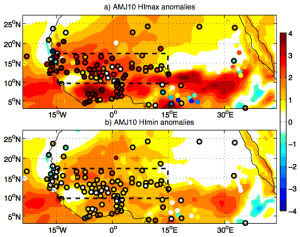l’article du mois – janvier 2017
 Characterisation of Heat Waves in the Sahel and Associated Physical Mechanisms
Characterisation of Heat Waves in the Sahel and Associated Physical Mechanisms
Oueslati B, B Pohl, V Moron, S Rome & S Janicot
Journal of Climate, in press.
Large efforts are made to address Heat Waves (HWs) in developed countries because of their devastating impacts on society, economy and environment. However, HWs are still understudied over developing countries. This is particularly true in West Africa, and especially in the Sahel, where temperatures recurrently reach critical values, such as during the 2010 HW event in Western Sahel. Our work aims at characterizing the Sahelian HWs during boreal spring seasons (April-May-June) and understanding the mechanisms associated with such extreme events. Over the last three decades, Sahelian HWs have been becoming more frequent, lasting longer, covering larger areas and reaching higher intensities.
The physical mechanisms associated with HWs are examined to assess the respective roles of atmospheric dynamics, radiative and turbulent fluxes by analysing the surface energy budget. Results suggest that the greenhouse effect of water vapour is the main driver of HWs in western Sahel, increasing minimum temperatures by enhanced downward longwave radiation. Atmospheric circulation plays an important role in sustaining these warm anomalies by advecting moisture from the Atlantic Ocean and the Guinean coasts into the Sahel. Maximum temperature anomalies are mostly explained by increased downward shortwave radiation due to a reduction in cloud cover. Interannual variability of HWs is affected by the delayed impact of El Nino Southern Oscillation (ENSO), with anomalous temperature warming following warm ENSO events, resulting from an amplified water vapour feedback.
- extrait:
- lien_externe:
- kc_data:
- a:8:{i:0;s:0:"";s:4:"mode";s:0:"";s:3:"css";s:0:"";s:9:"max_width";s:0:"";s:7:"classes";s:0:"";s:9:"thumbnail";s:0:"";s:9:"collapsed";s:0:"";s:9:"optimized";s:0:"";}
- kc_raw_content:
 Characterisation of Heat Waves in the Sahel and Associated Physical Mechanisms
Characterisation of Heat Waves in the Sahel and Associated Physical MechanismsOueslati B, B Pohl, V Moron, S Rome & S Janicot
Journal of Climate, in press.
Large efforts are made to address Heat Waves (HWs) in developed countries because of their devastating impacts on society, economy and environment. However, HWs are still understudied over developing countries. This is particularly true in West Africa, and especially in the Sahel, where temperatures recurrently reach critical values, such as during the 2010 HW event in Western Sahel. Our work aims at characterizing the Sahelian HWs during boreal spring seasons (April-May-June) and understanding the mechanisms associated with such extreme events. Over the last three decades, Sahelian HWs have been becoming more frequent, lasting longer, covering larger areas and reaching higher intensities.
The physical mechanisms associated with HWs are examined to assess the respective roles of atmospheric dynamics, radiative and turbulent fluxes by analysing the surface energy budget. Results suggest that the greenhouse effect of water vapour is the main driver of HWs in western Sahel, increasing minimum temperatures by enhanced downward longwave radiation. Atmospheric circulation plays an important role in sustaining these warm anomalies by advecting moisture from the Atlantic Ocean and the Guinean coasts into the Sahel. Maximum temperature anomalies are mostly explained by increased downward shortwave radiation due to a reduction in cloud cover. Interannual variability of HWs is affected by the delayed impact of El Nino Southern Oscillation (ENSO), with anomalous temperature warming following warm ENSO events, resulting from an amplified water vapour feedback.
